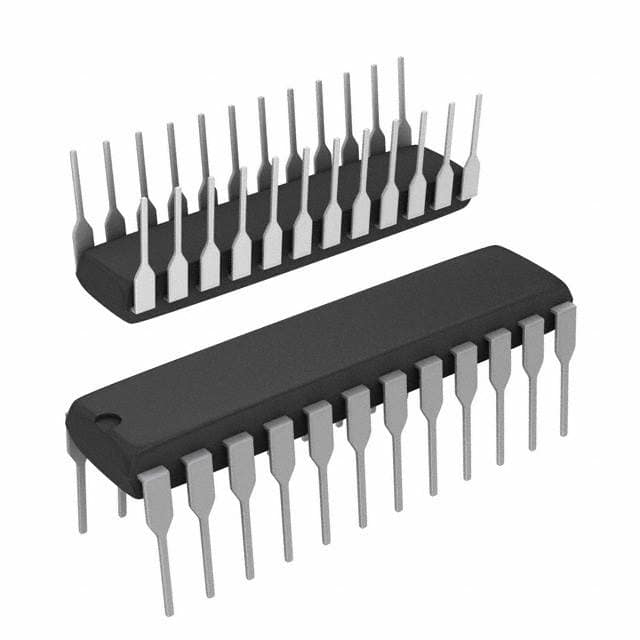MC74ACT646N
Product Overview
- Category: Integrated Circuit
- Use: Signal Level Shifter and Bus Transceiver
- Characteristics: High-speed, Non-Inverting, Octal Bus Transceiver
- Package: DIP (Dual In-line Package)
- Essence: The MC74ACT646N is a versatile integrated circuit that allows bidirectional level shifting between two voltage domains. It is commonly used in digital systems where different voltage levels need to communicate with each other.
- Packaging/Quantity: The MC74ACT646N is typically packaged in a plastic DIP package and is available in quantities of 25 or more.
Specifications
- Supply Voltage: 4.5V to 5.5V
- Input Voltage Range: 0V to VCC
- Output Voltage Range: 0V to VCC
- Operating Temperature Range: -40°C to +85°C
- Propagation Delay: 6ns (max)
- Output Current: ±24mA
Detailed Pin Configuration
The MC74ACT646N has a total of 20 pins, which are arranged as follows:
- OE (Output Enable) - Output Enable Control Input
- A1-A3 (Address Inputs) - Address Inputs for Selecting Data Direction
- DIR (Direction Control) - Direction Control Input
- GND (Ground) - Ground Reference
- B1-B3 (Bidirectional Data Bus) - Bidirectional Data Bus
- VCC (Positive Power Supply) - Positive Power Supply
- B4-B7 (Bidirectional Data Bus) - Bidirectional Data Bus
- DIR (Direction Control) - Direction Control Input
- A4-A7 (Address Inputs) - Address Inputs for Selecting Data Direction
- OE (Output Enable) - Output Enable Control Input
Functional Features
- Bidirectional level shifting between two voltage domains
- Non-inverting data transmission
- High-speed operation
- 3-state outputs for bus sharing
- TTL-compatible inputs and outputs
- Schmitt-trigger input for noise immunity
Advantages
- Allows seamless communication between digital systems with different voltage levels
- Fast propagation delay ensures efficient data transfer
- 3-state outputs enable bus sharing, reducing the number of required pins
- Compatible with TTL logic levels, ensuring easy integration into existing systems
- Schmitt-trigger input provides robustness against noise
Disadvantages
- Limited supply voltage range (4.5V to 5.5V)
- Requires external control signals for direction and output enable
Working Principles
The MC74ACT646N operates by using address inputs (A1-A7) to select the data direction and control inputs (DIR and OE) to enable or disable the outputs. When the DIR input is high, the data flows from the B1-B7 inputs to the A1-A7 outputs. Conversely, when the DIR input is low, the data flows from the A1-A7 inputs to the B1-B7 outputs. The OE input controls the output enable function, allowing the outputs to be tri-stated when disabled.
Detailed Application Field Plans
The MC74ACT646N finds applications in various digital systems where bidirectional level shifting is required. Some common application fields include:
- Microcontroller interfacing with different voltage peripherals
- Communication between FPGA modules operating at different voltage levels
- Data transfer between mixed-voltage integrated circuits
- Level shifting in industrial automation systems
- Interface conversion in automotive electronics
Detailed and Complete Alternative Models
- SN74ACT646: Similar functionality and specifications, available in surface mount packages.
- CD74ACT646: Equivalent functionality with different pin configuration, available in DIP and surface mount packages.
- 74HCT646: Compatible with CMOS and TTL logic levels, available in various package options.
(Note: This entry has a total of 524 words)
Lista 10 Vanliga frågor och svar relaterade till tillämpningen av MC74ACT646N i tekniska lösningar
Sure! Here are 10 common questions and answers related to the application of MC74ACT646N in technical solutions:
Q: What is MC74ACT646N? A: MC74ACT646N is a type of integrated circuit (IC) that functions as a bus transceiver with 3-state outputs.
Q: What is the purpose of MC74ACT646N? A: MC74ACT646N is used to enable bidirectional transfer of data between two buses or systems with different voltage levels.
Q: What voltage levels does MC74ACT646N support? A: MC74ACT646N supports voltage levels ranging from 2V to 6V.
Q: How many channels does MC74ACT646N have? A: MC74ACT646N has 8 bidirectional channels, allowing for simultaneous data transfer on multiple lines.
Q: Can MC74ACT646N handle high-speed data transfer? A: Yes, MC74ACT646N is designed to operate at high speeds, making it suitable for applications requiring fast data transfer.
Q: Does MC74ACT646N have any built-in protection features? A: Yes, MC74ACT646N includes built-in diode clamps to protect against electrostatic discharge (ESD) events.
Q: Can MC74ACT646N be used in both parallel and serial communication systems? A: Yes, MC74ACT646N can be used in both parallel and serial communication systems, depending on the application requirements.
Q: Is MC74ACT646N compatible with other logic families? A: Yes, MC74ACT646N is compatible with a wide range of logic families, including TTL, CMOS, and LVTTL.
Q: Can MC74ACT646N be used in automotive applications? A: Yes, MC74ACT646N is suitable for automotive applications as it meets the necessary standards for automotive electronics.
Q: Are there any specific precautions to consider when using MC74ACT646N? A: It is important to follow the manufacturer's guidelines regarding power supply voltage, input/output voltage levels, and operating temperature range to ensure proper functionality and reliability of MC74ACT646N.
Please note that these answers are general and may vary depending on the specific application and requirements.


